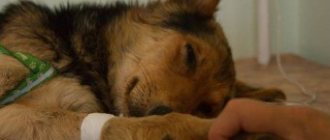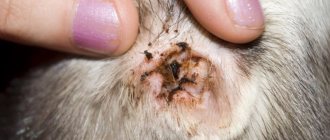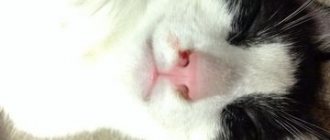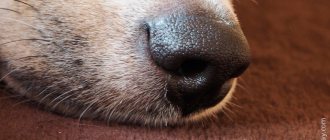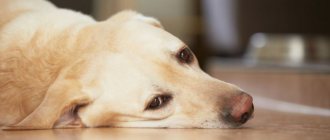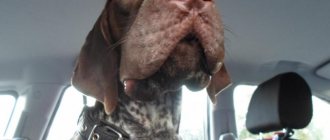Almost every person has encountered such a problem as a runny nose. But pets can also experience this symptom. Dogs suffer from the inability to breathe normally due to snot just as much as humans.
The causes of nasal discharge in a dog can be different. These include colds caused by viruses, anatomical defects, or more serious diseases, the progression of which is very dangerous for the life of the animal. If your pet has a runny nose, there is no need to panic. In some cases, you can help the dog yourself. But if the nasal discharge is chronic, cloudy, green and accompanied by other symptoms, it is better to seek help from a veterinarian.
Causes
The appearance in dogs can be caused by various reasons:
- Ingress of foreign particles - these can be grains of sand, blades of grass, hairs. They irritate the mucous membranes, cause sneezing, and the discharge of clear liquid from the nose (usually from one nostril).
- Allergies – a dog’s immune system can perceive the entry of certain substances into the body as foreign agents (food, pollen, shampoos). As a result of an immune attack, the animal develops liquid transparent snot, itching, coughing, and swelling of the nasal mucosa.
- Hypothermia due to getting wet in the rain or a long walk in cold weather. In such cases, thermoregulation is disrupted and the animal develops snot.
- Mechanical damage to the olfactory organs or abnormalities of the oral cavity (nasal fracture, cleft palate). The dog develops a runny nose and may have difficulty breathing.
- Neoplasms in the nose (cysts, tumors). In such cases, standard treatment of a runny nose with rinses, drops and other means is ineffective.
- Viral and bacterial infections (adenovirosis, plague). They are often disguised as a common cold and are very dangerous for your dog. Without timely treatment, the animal may die.
- Parasites (helminths, ticks, fleas, lice eaters) - when they get on the nasal mucosa, they cause irritation, the dog begins to sneeze, and clear discharge appears from the nasal passages.
View a list of small dog breeds with photos and names, and also learn about keeping miniature pets.
Is it possible to give bones to dogs? Prohibited and permitted types of treats can be seen in this article.
Risk group
There are dog breeds for which clear, moderate snot is the norm. This is associated with brachycephalic syndrome in short-faced dogs (pug, bulldog, Pekingese). The shortened nose and very soft tissues on the muzzle do not allow the respiratory system to function normally. The result is a runny nose. There is no need to treat it in such cases.
Main predisposing factors
A runny nose in dogs can be the result of many different diseases. neoplasia can cause this effect
, as well as
idiopathic lymphoplasmacytic and fungal rhinitis
. But there are still many more real reasons.
Much worse is the fact that mucous discharge from the nasal cavity may well indicate some severe systemic disorders in the body. In this case, depression, hyperthermia, and nosebleeds often develop. But in such cases, a runny nose never develops suddenly: the pathology evolves gradually, against the backdrop of a constant deterioration in the dog’s health. It’s quite difficult not to notice this. Major systemic pathologies that can cause this effect include:
- coagulopathy;
- vasculitis;
- arterial hypertension;
- pneumonia;
- bronchitis;
- laryngitis;
- tracheitis, etc.
It should be noted that the nature and type of nasal discharge can be extremely helpful in making a diagnosis. In particular, fungal rhinitis is characterized by the appearance in the exudate of many whitish “lumps”, which are both pieces of mycelium (mycelium of the pathogen) and fragments of collapsing tissues of the nasopharynx.
Never, under any circumstances, use nasal drops intended for humans to “treat” your pet. This way you can easily poison your pet or cover up the symptoms!
Common causes of rhinitis in dogs
To better understand the variety of predisposing factors, you need to familiarize yourself with the table below, which describes the main reasons.
But even this list is not half complete. Therefore, when diagnosing, a veterinarian has to be extremely careful and pay close attention to any factors, even if they seem insignificant.
About the important features of the secreted exudate
Serous
nasal discharge
is the most uncharacteristic, as it is noticed in the initial stages of almost all types of nasopharyngeal diseases. Subsequently, it almost always turns into catarrhal, purulent or another form, from which the root cause of what is happening can be judged with a greater degree of confidence. This happens because at first the bacterial, viral or fungal microflora does not yet have time to “settle in” to the proper extent, and therefore there are still no signs of a specific infection.
Catarrhal-purulent
(mucous discharge of a greenish or greenish-yellow color) nasal discharge is the most common and often indicates bacterial contamination of the nasopharyngeal organs. It can also indicate almost any systemic bacterial infection of the body. Often purulent discharge from the nose is the result of a serious injury or foreign body. This is also indicated by blood, which in such cases is abundantly mixed with “normal” secretions. Note that primary infections that cause a purulent inflammatory process in the thickness of the nasal cavity and sinuses are quite rare in dogs.
In addition, attention should be paid to where exactly the exudate is coming from: from one or both nostrils. So one-way ejection
often associated with neoplasia, fungal rhinitis or foreign body entry, inflammatory processes caused by periodontal diseases.
Bilateral discharge
is typical for systemic disorders, neoplasia, fungal rhinitis, idiopathic lymphoplasmacytic and allergic types. However, in the last two cases, with equal probability, only unilateral discharge of exudate may be present, so these signs alone will clearly not be enough for an accurate diagnosis.
Possible diseases and their symptoms
You can diagnose snot in a dog yourself. They are usually accompanied by:
- sneezing;
- rubbing the nose with paws;
- nasal discharge of various types.
At first, the consistency of the discharge is liquid. Over time, the snot thickens. They dry out in the nose, forming crusts. Because of this, it becomes difficult for the dog to breathe; it breathes through its mouth.
If rhinitis develops as a separate disease, then the general condition of the animal, as a rule, is not disturbed. He has a good appetite. In acute form, with timely treatment, rhinitis goes away within a week. If the disease has developed into a chronic form, exacerbations will periodically occur. The dog may be depressed and lose weight.
If a runny nose occurs as a symptom of other pathological conditions, it may be present for a long time. To make a correct diagnosis, it is better to consult a veterinarian and also observe the nature of the nasal discharge and what other symptoms are present.
If the snot becomes thick and acquires a greenish tint, then the process is already quite advanced and bacterial microflora has become attached. The dog is sneezing and keeps trying to scratch its nose. If there is an infection, the animal's temperature may rise, the mucous membranes of the nasopharynx may become hyperemic and swell.
If the discharge appears against the background of an allergic reaction, then the discharge will be not only from the nose, but also from the eyes. Other allergy symptoms:
- itching;
- sneezing;
- skin rashes;
- swelling.
If a foreign body gets into the nose, the animal will do its best to show that something is bothering it: rub its nose with its paws, actively shake its head, try to sneeze out. If it flows from only one nostril, you can suspect the presence of a neoplasm. Bloody discharge may appear. And the further the disease progresses, the more often they will appear. As the formation grows, deformation of the bridge of the nose and muzzle occurs. Ichor may appear in the snot. Changes in the shape of the nose and muzzle are also possible due to injury.
Severe infections are accompanied by the development of additional symptoms:
- weakness;
- heat;
- lack of appetite;
- thirst;
- vomit.
You should not let the presence of snot in a dog take its course. Often this symptom is just the tip of the iceberg of dangerous diseases. Therefore, it is better to carry out diagnostics in the clinic.
Why is muzzle swelling dangerous?
Regardless of the symptoms, swelling of the dog’s muzzle and other parts of the body often goes away spontaneously
.
However, do not forget that an allergic reaction can occur in mild or severe form
. The mild form is urticaria (dermatitis). A severe, acutely developing allergic reaction – Quincke's edema.
Symptoms of Quincke's edema:
- difficult shallow breathing;
- shortness of breath, wheezing;
- exhausting;
- strong muzzle, eye;
- cyanosis, mucous membranes;
- muscle spasms, cramps;
- temperature drop;
This pathology causes severe spasm of the muscular structures of the larynx. Edema interferes with the normal functioning of the respiratory tract. The dog may choke
. In some cases, Quincke's edema occurs simultaneously with urticaria. A red rash, papules, plaques, and scratches are noticeable on the pet's body. The dog is experiencing severe itching.
The most severe form of allergy, which poses a real threat to the dog’s life, is anaphylactic shock.
(anaphylaxis).
In this case, you need to call a veterinarian at home as soon as possible or take the animal to a veterinary clinic. Every minute of delay could cost your dog's life.
Swelling can be localized in any part of the muzzle. In this case, most often in dogs the upper part of the head, the area in the lower jaw area, swells. This condition may be accompanied by severe itching, pain, increased general body temperature, vomiting, and other symptoms.
General rules and methods of treatment
Treatment directly depends on what caused the runny nose. After all, colds, allergies, or rhinitis associated with the presence of a tumor are treated differently. The veterinarian always has the final say.
General rules
Before you start giving the animal any medications or performing procedures, you need to ensure comfortable conditions:
- place the pet in a warm place, do not let it lie on the cold floor;
- do not stay in a cool room;
- eliminate drafts;
- the humidity level in the room should be within 60% so that the dog’s nasal mucosa does not dry out; excessive humidity is also undesirable;
- Reduce walking outside to a minimum;
- Give plenty of clean warm water.
During treatment, it is necessary to regularly check the dog's temperature, even if the animal is externally active. There are cases that snot appears as a harbinger of some serious illness.
Self-medication is prohibited! Use any medications only with the approval of a veterinarian.
Nasal drops
There are many types of drops that have different compositions and have different effects.
If your dog has clear, watery nasal discharge due to a cold, you can use the following drops:
- Derinat;
- Pinosol;
- Eucasept.
These are herbal oil-based products. You need to instill 2-3 drops into each nostril twice a day for 1-2 weeks.
You can use Anandin drops. The drug has an anti-inflammatory, bactericidal, tonic effect. These drops are suitable for both the nose and eyes. It is recommended to apply nasal drops three times a day. The number of drops is determined by the dog's weight. 1-4 drops are usually used in each nostril. It is not recommended to be treated with Anandin for more than 2 weeks. The drug becomes addictive and becomes ineffective.
To strengthen the immune system, you can use Maxidin drops. Inject 1-2 drops into each nostril 2-3 times a day.
Warming up
In case of a cold, if there is no purulent discharge or bleeding, as well as nasopharyngeal injuries, you can help the animal by warming it up. Place a bag of warm salt, sand or buckwheat on the bridge of your nose. Leave for 10-15 minutes. It is recommended to repeat the procedure three times a day.
Washing
To quickly free the nasal passages from accumulated secretions and prevent them from thickening, it is recommended to rinse the nose. To do this, use special solutions heated to body temperature, which are injected into the nasal passages using a rubber bulb or a syringe without a needle. Carefully inject the solution into each nasal passage in small portions, waiting for it to flow out. The mucus will come off and the animal may begin to sneeze.
To rinse your nose you can use:
- saline 0.9%;
- boric acid no more than 3%;
- furatsilin (1 tablet dissolved in 200 ml of water);
- soda 1%;
- dixidin 1%, diluted with water to 0.5%;
- potassium permanganate.
Antibiotics
If there is snot that is accompanied by a bacterial infection, the doctor will prescribe antibiotics.
Typically, drugs with a broad spectrum of action are used:
- Penicillin;
- Cefatoxime;
- Cefix;
- Amoxicillin and others.
For fibrotic rhinitis, it is recommended to administer antibiotics from the sulfonamide group.
Immunotherapy and vitamin therapy
In order for the body to recover faster during the treatment process, the dog needs to strengthen its immune system. For these purposes, the dog is given immunomodulatory agents and vitamins. They are especially recommended for viral infections.
Effective drugs:
- Ribotan - administered intramuscularly once 0.5-2 ml for 5 days.
- Immunofan - injected into the withers area once a day for 5-7 days.
- Cycloferon - 5 injections in total: 2 days in a row, 1 injection, then every other day. The dosage depends on the weight of the animal.
To replenish vitamins, it is recommended to enrich the diet with foods containing vitamins A, C, E, and group B.
Folk remedies
When a dog has a cold, sometimes folk methods are used for the dog’s nose. Decoctions that effectively relieve inflammation and cleanse the nasal passages:
- chamomile;
- sequences;
- coltsfoot;
- violets.
Juices:
- onion;
- beet;
- carrot.
It is recommended to dilute them with warm boiled water first.
Why does a dog ride on its butt? Learn about the causes and treatment of possible diseases.
The rating of holistic class dog food, characteristics of dry and canned food can be seen in this article.
On the page, read about why your dog's breath smells and how to eliminate the unpleasant odor.
Prohibited actions
Not all measures to eliminate snot in a dog can benefit the animal.
Forbidden:
- the use of vasoconstrictor drops (Naphthyzin, Galazolin), they dry out the nasal mucosa;
- warming with salt, sand and other means in the presence of green and thick snot.
Treatment of allergic rhinitis
If your dog's nasal discharge is the result of an allergy, you must first remove the allergen's exposure to the body.
After this, you can give the animal an antihistamine:
- Ketotifen;
- Suprastin;
- Cetrin.
How to treat snot in a dog at home
On the World Wide Web you can find various folk remedies for this disease. Below we list the main ones:
- You can lubricate your nose with menthol oil or use oil-based drops.
- It is also recommended that if you have an allergic rhinitis, rinse your nose with hydrogen peroxide and lubricate it with Vaseline.
- Lubricate your dog's nose with menthol ointment twice a day, or make a treatment mixture at home by mixing soda and tannin. Prepare your own solution from a solution of soda and tannin. It is worth noting that the concentration of soda and tannin should be no more than 1%.
- There is also one way to treat your pet’s sniffles, but it is important to note that it is quite risky and not many people recommend using it, since a dog’s nose is a very sensitive area. And so the remedy is to moisten a cotton swab in onion or beet juice and apply it to the dog’s nostrils. During this procedure, watery wear will begin to appear, along with which the infection and foreign objects should be washed out.
In what cases should you contact a veterinarian?
If the animal's nasal discharge is clear, lasts no more than 2-3 days and the general condition is normal, then you can cope with the problem yourself. But if the snot does not disappear for more than 3 days after the measures taken, and changes its consistency and color, it is better to show the dog to the veterinarian.
A doctor is especially necessary if the pet becomes worse and the animal exhibits negative symptoms:
- cough;
- difficulty breathing;
- bowel dysfunction;
- discharge from the eyes;
- lethargy and apathy, or, conversely, aggressiveness;
- lack of appetite.
Cancer tumor
In many cases, the initial signs of the disease occur like a cold, accompanied by mucous discharge, swollen nose, difficulty breathing, and bloody discharge. If the diagnosis is incorrect, inadequate anti-inflammatory physiotherapy is carried out. Due to all the procedures used, there is a strong progression of the nasal tumor. There is destruction of the facial skull and nerve damage.
Cancer activity also affects the lymph nodes and lungs. Unfortunately, if the disease is incorrectly identified, patients go to veterinary clinics too late, which negatively affects the disease process. For correct diagnosis, it is necessary to remember the existence of such a disease.
You should constantly pay attention to changes in the area of the nose, indicating initial damage to the dog’s nasopharynx.
The animal’s nose, as described by many authors, is considered a difficult-to-reach area for initial examination and diagnosis. To examine the entire nose, rhinoscopy is used, as well as x-ray diagnostics, which make it possible to determine the stage of the disease and the condition of the nasal sinuses.
Treatment tactics for your pet are selected by determining the morphological variant of the tumor. Any malignant formations are particularly sensitive to different types of therapy. In operable cases, an electrosurgical section is performed.
We must remember that tumors can have a malignant appearance, and if you go to the clinic in a timely manner, the effect of treatment will be much more noticeable.
